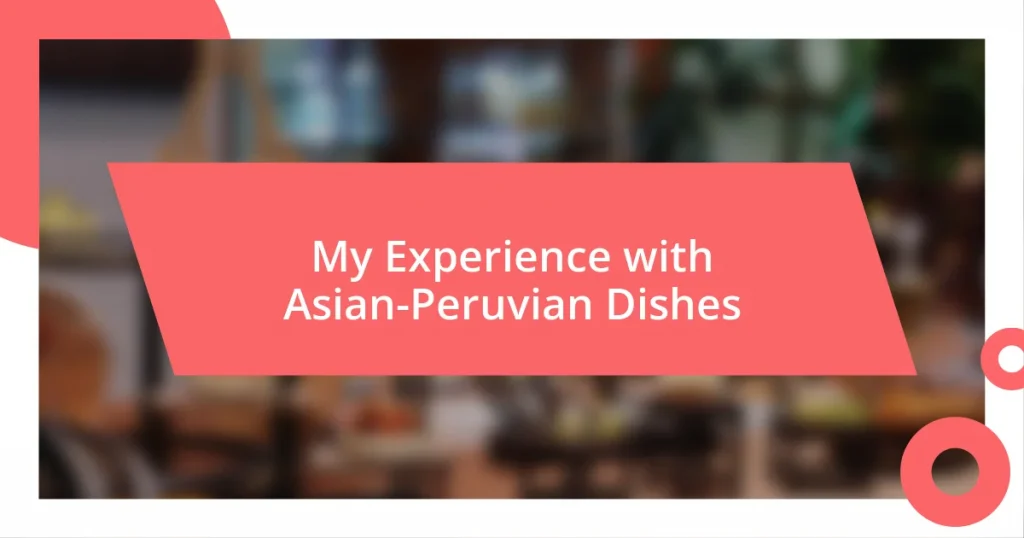Key takeaways:
- Peruvian cuisine is a blend of diverse cultures and ingredients, highlighted by dishes like ceviche and lomo saltado, which evoke deep emotional connections and cultural celebrations.
- Key ingredients such as ají peppers, potatoes, and quinoa play a vital role in traditional dishes, each contributing unique flavors and reflecting Peru’s agricultural heritage.
- Pairing drinks thoughtfully with Peruvian food enhances the dining experience, with combinations like Pisco Sour and ceviche providing a harmonious balance of flavors.

Understanding Peruvian cuisine
Peruvian cuisine is a vibrant tapestry woven together by indigenous ingredients, and culinary influences from Asia, Europe, and Africa. When I first tasted ceviche as a child, I could hardly wrap my mind around the idea of raw fish marinated in lime juice. What I felt, though, was a burst of flavors that took me on a journey across coastal regions, reflecting Peru’s rich marine biodiversity.
What truly strikes me about Peruvian food is its versatility. For instance, the use of potatoes—over 3,000 varieties are found in Peru—demonstrates a unique approach to comfort food. Have you ever experienced the warmth of a hearty causa, where layers of creamy potato and fresh ingredients come together? Each bite tells a story, and I find myself reminiscing about family gatherings where food was not just sustenance but a celebration of culture and community.
Moreover, I find it fascinating how traditional dishes like lomo saltado symbolize the fusion of cultures, blending Peruvian and Chinese influences to create something distinctly unique. Imagine the joy of savoring tender beef stir-fried with tomatoes and served over rice, a dish that feels like a warm hug after a long day. How does a meal evoke such deep emotions? For me, it’s the connections formed around the table, the laughter, and the shared plates that make Peruvian cuisine a heartfelt experience.

Popular traditional dishes
Exploring the realm of traditional Peruvian dishes leads to some truly delightful experiences. I remember the first time I enjoyed ají de gallina, a dish featuring shredded chicken in a creamy, slightly spicy sauce. The warmth of the ají pepper combined with the richness of the sauce felt like a cozy embrace, bringing comfort on a chilly evening. Each bite was a reflection of home, connecting me to my roots and the labor of love that goes into preparing such a beloved meal.
Here are some popular traditional dishes that showcase the diversity and flavor of Peruvian cuisine:
- Ceviche: Fresh fish marinated in lime juice, mixed with onions and cilantro.
- Lomo Saltado: Stir-fried beef with tomatoes and onions, served with rice and fries.
- Aji de Gallina: Shredded chicken in a creamy, spicy sauce, often served with rice.
- Causa Limeña: A layered dish of mashed potatoes, avocado, and various fillings.
- Pollo a la Brasa: Marinated rotisserie chicken, known for its juicy flavor and smoky aroma.
I can’t emphasize enough how each dish not only fills your stomach but also nourishes the soul. Remembering the laughter shared over a steaming pot of tallarines verdes, a vibrant green pasta dish, brings a smile to my face. There’s a certain magic in these meals; they invite stories, laughter, and a rich tapestry of memories that linger long after the last bite.
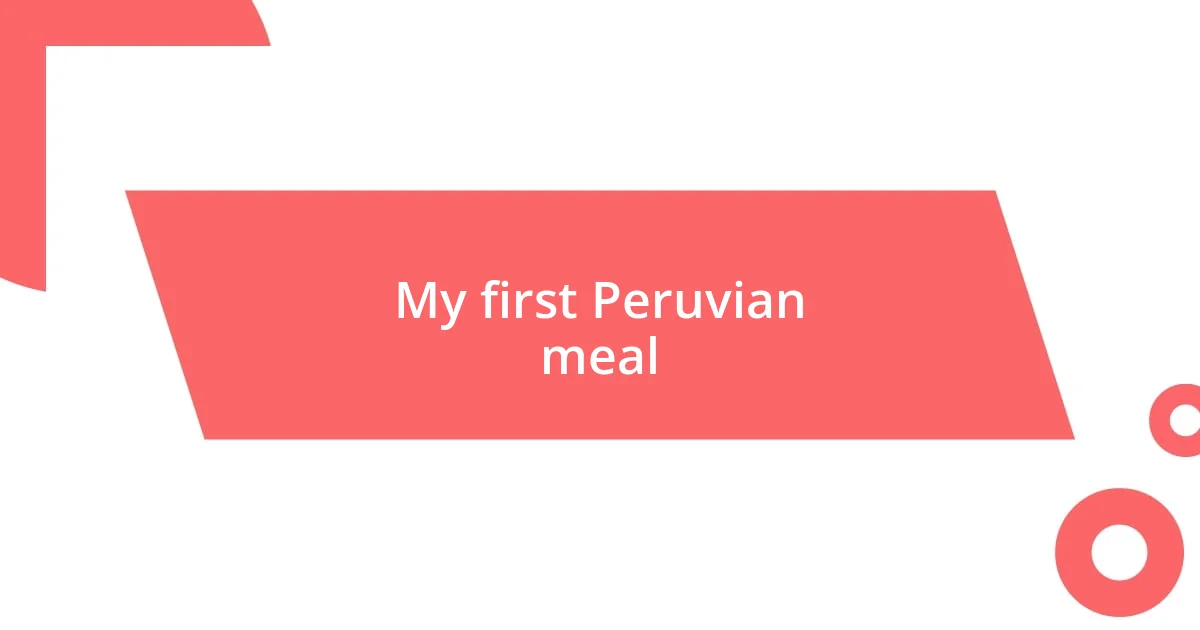
My first Peruvian meal
When I think back to my first Peruvian meal, I can almost taste the vibrant spices and fresh ingredients that made it unforgettable. I remember sitting at a bustling local restaurant, nervously anticipating my order. As I took that first bite of ceviche, the tangy lime and the tender fish exploded in my mouth. It was an experience that awakened my taste buds, making me realize that this culinary journey would be one filled with unforgettable flavors and textures.
It wasn’t just the food itself that captivated me; it was the atmosphere surrounding me. Families gathered around tables, laughter echoing through the air, and the sizzling sounds from the kitchen created a welcoming symphony. Each table felt like a small celebration of life. I could see the joy on everyone’s faces as they shared plates of lomo saltado and ají de gallina, creating a sense of community fueled by shared culinary love. It truly solidified my appreciation for Peruvian cuisine as not just something to eat, but a way to connect with others.
Looking back, that first meal was more than just a dish; it was a colorful invitation to explore a rich culinary landscape. Every taste, every dish, told me a story. Whether it was the warmth of the potatoes in causa or the kick of spice in ají de gallina, each bite deepened my connection to this incredible culture. Doesn’t food have a way of doing just that? It pulls us into new worlds, crafting relationships that can last a lifetime over a shared meal.
| Dishes | Key Ingredients |
|---|---|
| Ceviche | Fresh fish, lime juice, onions, cilantro |
| Lomo Saltado | Beef, tomatoes, onions, rice, fries |
| Ají de Gallina | Shredded chicken, ají pepper, cream, rice |
| Causa Limeña | Mashed potatoes, avocado, fillings |
| Pollo a la Brasa | Marinated chicken, spices |
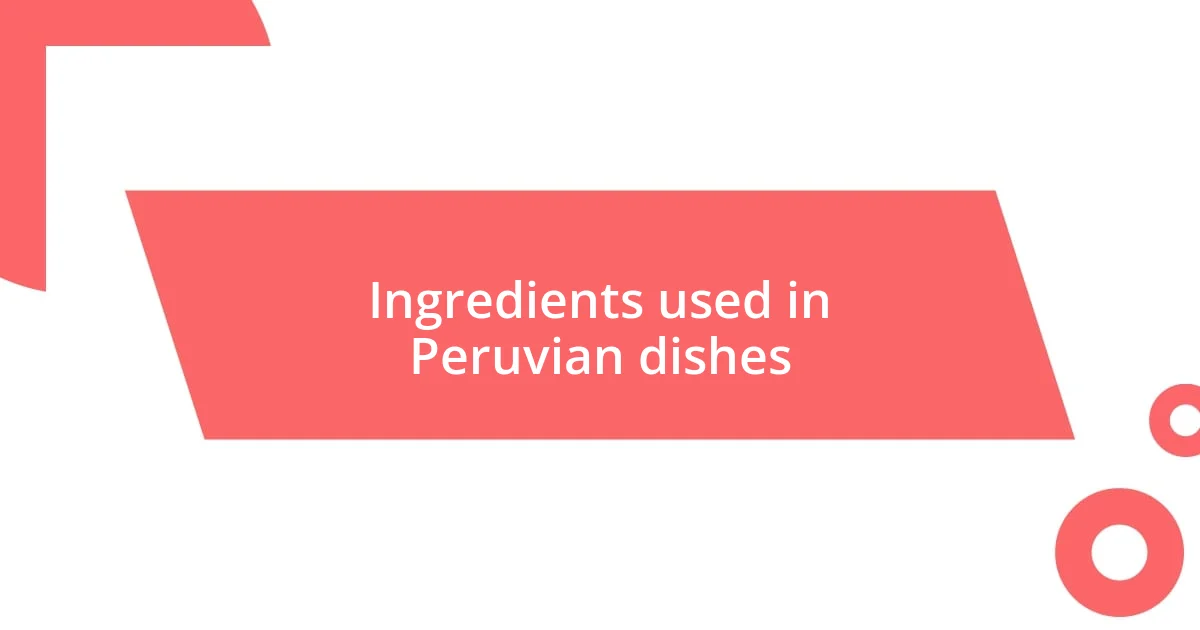
Ingredients used in Peruvian dishes
The beauty of Peruvian cuisine lies in its diverse array of ingredients, each adding a unique flavor profile to the traditional dishes. During my culinary explorations, I found that staple items like ají peppers, potatoes, and corn form the backbone of many recipes. I remember the thrill of discovering over 4,000 varieties of potatoes in Peru, each one with its distinct texture and taste—who knew a humble tuber could offer so much variety?
As I experimented in my kitchen, I learned about the crucial role of fresh herbs, particularly cilantro, in enhancing the flavor of dishes like ceviche. The refreshing burst of cilantro, combined with the zesty lime juice, truly enlivens the fish. There’s something magical about the first time you taste that balance of flavors—it’s like a dance on your palate that leaves you craving more. Have you ever had an ingredient change the way you feel about a dish?
Another ingredient that caught my attention is quinoa, often hailed as a superfood. I vividly recall making a hearty quinoa salad filled with various vegetables and a tangy dressing. It was not just healthy; it felt like a celebration of Peruvian culture on my plate. The grain’s nutty flavor, paired with vibrant veggies, reminded me of the colorful markets I explored while visiting Peru. Each ingredient tells a story of the region’s rich agricultural heritage, bringing food lovers closer to the land and its people.
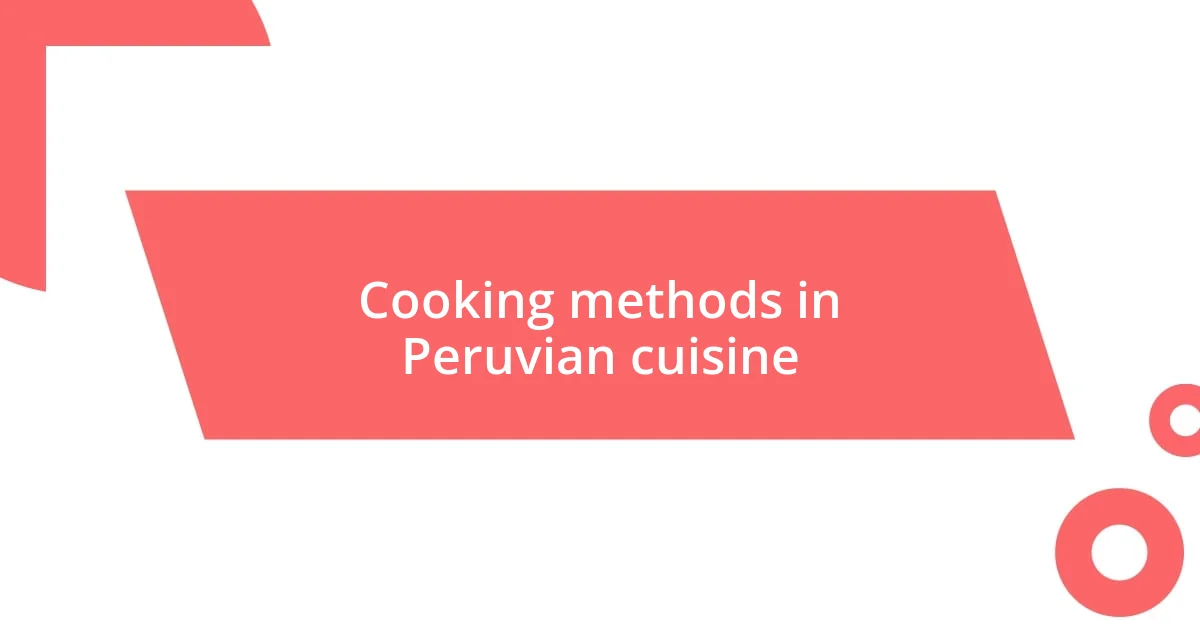
Cooking methods in Peruvian cuisine
The cooking methods in Peruvian cuisine are a fascinating blend of tradition and innovation. One method that stands out to me is the use of Parque, a technique that involves indirect cooking, often seen in dishes like Pollo a la Brasa. I was pleasantly surprised to discover how well marinating the chicken in a mix of spices elevates the final dish, saturating it with flavor while ensuring it stays juicy. Have you ever witnessed a technique transform an ordinary meal into an extraordinary experience?
Another aspect of culinary preparation I found particularly engaging is the use of steam cooking, especially in making tamales. I distinctly recall helping in the kitchen while preparing these delicious parcels. Wrapping the dough in banana leaves not only added a lovely earthy aroma but also gave it a unique texture. There’s something so satisfying about unwrapping a tamal, unveiling a steaming treasure of flavors within.
Then there’s the art of grilling, which brings out the best in meats and vegetables alike. I remember some evenings spent in a vibrant open-air grill market, where the aroma of skewered anticuchos sizzling over charcoal was intoxicating. The char adds a smoky dimension that takes simple ingredients and turns them into a festive feast. It’s moments like these that remind me how much the cooking method can impact the overall dining experience. What about you—have you ever preferred one cooking method over another due to the flavors it evokes?
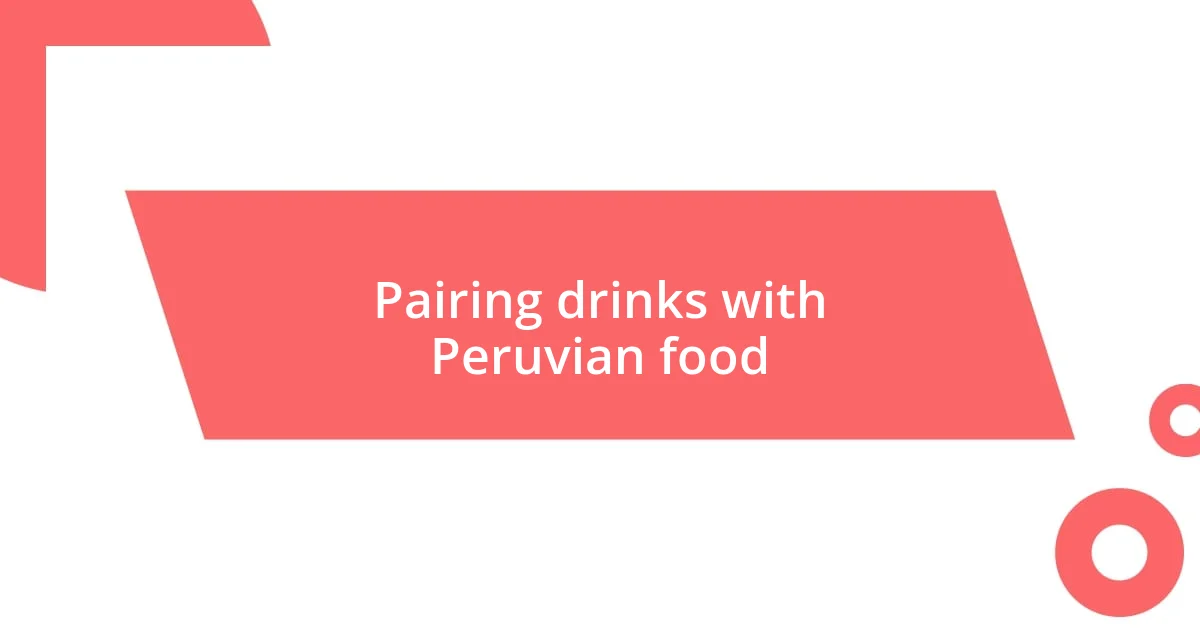
Pairing drinks with Peruvian food
Pairing drinks with traditional Peruvian food requires thoughtful consideration to complement those vibrant flavors. One of my favorite combinations is sipping a chilled glass of Pisco Sour while indulging in classic cebiche. The cocktail’s citrus notes harmonize beautifully with the fresh, tangy marinated fish—an experience that always takes me back to sun-soaked coastal afternoons in Peru. Have you ever found a drink that instantly transports you to a cherished moment in time?
When it comes to heartier dishes like Aji de Gallina, I tend to reach for a light, crisp beer, such as a Peruvian lager. I vividly recall enjoying this pairing one evening at a local restaurant in Lima, where the beer’s refreshing quality counterbalanced the creamy richness of the dish. It made me appreciate how a simple beverage can enhance the entire meal—almost like an extra layer of flavor. Isn’t it fascinating how the right drink can elevate a dish beyond its intrinsic qualities?
And of course, we can’t overlook the delightful opportunity for creativity in these pairings. I once tried a surprising mix of floral chicha morada, a sweet Peruvian beverage made from purple corn, with spicy anticuchos. The drink’s hints of cinnamon and clove complemented the heat of the skewered meats in a way that took me by surprise. This experience was a revelation, showing me that sometimes, breaking the rules can lead to delightful culinary discoveries. What unique beverage pairings have you stumbled upon that completely changed your meal?

Tips for enjoying Peruvian dishes
To truly enjoy Peruvian dishes, I recommend starting with the right mindset: be open to exploring new flavors and textures. When I first tried causa, a delicious layered potato dish, I didn’t expect the combination of creamy avocado and tangy lime to create such a delightful contrast. Each bite was a revelation, reminding me to embrace the unexpected in my culinary adventures. Have you ever tasted something that completely changed your perception of a particular ingredient?
Another tip I’ve gathered from my experiences is to savor the presentation of the dishes. When the vibrant colors of a ceviche dance on the plate, it invites you to dig in, almost like a work of art. I remember the first time I attended a Peruvian food festival, and the way the chefs curated their plates was mesmerizing. Observing the careful arrangement made each dish feel more special and worthy of respect. Do you enjoy taking a moment to appreciate the visual aspect of your meals before indulging?
Lastly, don’t shy away from engaging with those around you while enjoying your meal. Sharing a plate of anticuchos with friends becomes a celebration in itself, filled with laughter and conversation. I once found myself at a street food stall, bonding with fellow food lovers over the spicy, smoky flavors of grilled heart skewers. Those connections amplified the flavors, creating not just a meal, but a memorable experience. How do you think the social aspect of dining influences the enjoyment of food?















